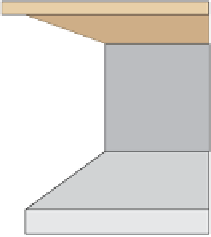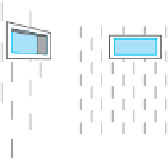Geology Reference
In-Depth Information
your house. Because radon is a naturally occurring gas, con-
tact with it is unavoidable, but atmospheric concentrations of
it are probably harmless. Only when concentrations of radon
build up in poorly ventilated structures does it become a po-
tential health risk.
Radon was discovered in 1900 by the German chemist
Friedrich Ernst Dorn, but its effects were noted as early as the
16th century when miners in Central Europe were dying of
lung disease. Concerns about the health risks of radon in the
United States began during the 1960s when the news media re-
vealed that some homes in the West were built on the rock de-
bris left over from uranium mining. However, it was an incident
in 1984 that really brought the dangers of radon to the atten-
tion of the public. Stanley Watras set off the radiation detector
at the nuclear power plant in Limerick, Pennsylvania, where he
worked, and subsequent investigations revealed that his home,
which was built on a uranium deposit, had radon concentra-
tions as high as 2700 pCi/L, 650 times the national average. The
Watras house and others in the area were built on a uranium-
bearing body of rock called the Reading Prong which underlies
parts of Pennsylvania, New York, and New Jersey.
Since radon has been recognized as a hazard, geologists
have found that high indoor radon levels are caused by natu-
ral uranium in the minerals of the rock and soil on which
buildings are constructed. In response to the high cost of
energy during the 1970s and 1980s, existing buildings were
insulated and new ones were constructed to be as energy effi -
cient and air-tight as possible. Ironically, these energy-saving
measures also sealed in radon.
Radon enters buildings through dirt floors, cracks in
fl oors or walls, joints between fl oors and walls, fl oor drains,
sumps, and utility pipes, as well as any cracks or pores in hol-
low block walls (
measures to reduce your risk. These include sealing up all
cracks in the foundation, pouring a concrete slab over a dirt
fl oor, increasing the circulation of air throughout the house,
especially in the basement and crawl space, and providing
fi lters for drains and other utility openings.
Some areas in the United States are more likely to have
higher natural concentrations of radon than others. Rocks such
as uranium-bearing granites, metamorphic rocks of granitic
composition, and black shales (high carbon content) are likely
to cause indoor radon problems. Other rocks, such as marine
quartz sandstone, noncarbonaceous shales and silstones, most
volcanic rocks, and igneous and metamorphic rocks rich in
iron and magnesium, typically do not cause radon problems.
The climate and the type of construction affect not only
how much radon enters a structure, but also how much es-
capes. Concentrations of radon are highest during the winter
in northern climates because buildings are sealed as tightly
as possible. Homes with basements are more likely to have
higher radon levels than those built on concrete slabs.
Currently, a heated debate is ongoing among scientists con-
cerning the large-scale health hazards resulting from radon ex-
posure and how much money should be spent on remediation.
A
geologic agent
is any process or phenomenon that
brings about change, such as running water, wind, waves, and
tectonism. Some of these, including seismicity, volcanism, and
plate movements, are unaffected by human activities, but oth-
ers are affected, especially those involving surface processes. All
human activities have geologic consequences. Whereas hunters
and gatherers have only a minimal impact on their environment,
industrialized societies have a huge impact. The standard of liv-
ing in developed nations is maintained by fi nding and exploiting
energy resources (oil, natural gas, coal, and uranium), metallic
resources (ores of iron, tin, zinc, etc.), and nonmetallic resources
(salt, gypsum, phosphate, etc.) (
Figure 24.5). Radon can also be released
into a building whenever the water is turned on, particularly
if the water comes from a private well.
To find out whether your home has a radon problem,
you must test for it with commercially available, simple
home-testing devices. If radon readings are above the recom-
mended EPA level of 4 pCi/L, you can take several remedial
◗
◗
Figure 24.6). Finding resources
usually causes little or no disruption to the environment, but ex-
ploiting them does. For instance, all the streams and rivers of the
world carry about 24 billion metric tons of sediment to the oceans
each year. By contrast, in mining and quarrying operations, hu-
mans move an estimated 3 trillion metric tons of earth materi-
als, although much of it remains at or near the site where it was
excavated.
A good example of just how effective humans are at dis-
rupting natural systems is well illustrated by the hydraulic min-
ing that took place during the 1850s in the California gold fi elds.
When miners fl ocked to California, beginning in 1849, a single
miner could process less than 1 m
3
of sediment per day, but with
the advent of hydraulic mining, in which a powerful jet of water
washed away entire hillsides, a miner could process more than
50 times as much sediment (
Water
supply
Block
walls
Slab
joints
Cracks
in floor
Figure 24.7a). The huge amount
of debris from hydraulic mining, about 1.15 billion cubic meters,
was dumped into local streams and rivers that could not handle
the increased sediment load. As a result, deposition took place in
their channels and on their fl oodplains and catastrophic fl ooding
occurred on the lower reaches of the waterways. In 1884, hydrau-
◗
Drain
Sump
◗
Figure 24.5
Radon Some of the points where radon can enter a
house.















































Search WWH ::

Custom Search